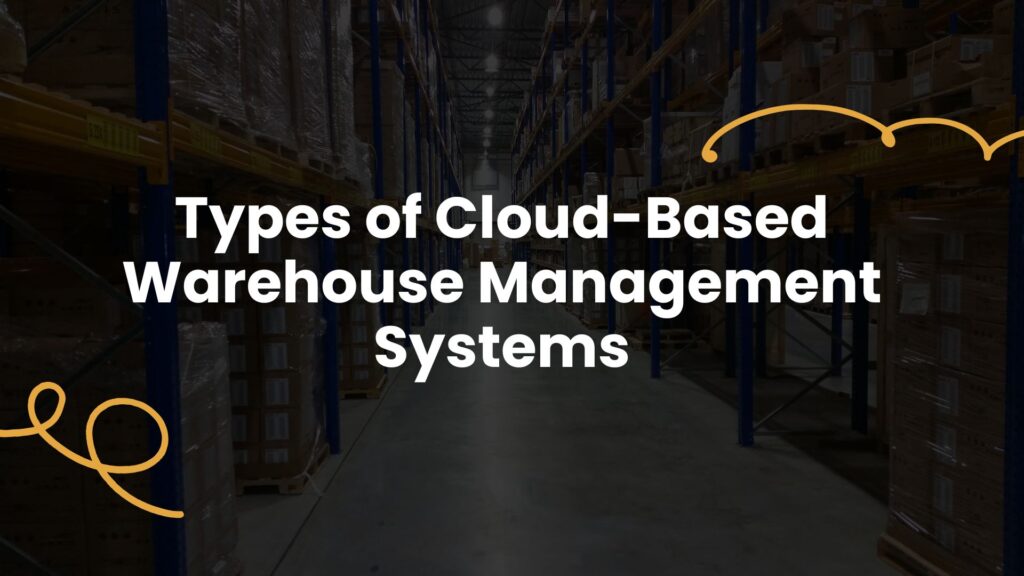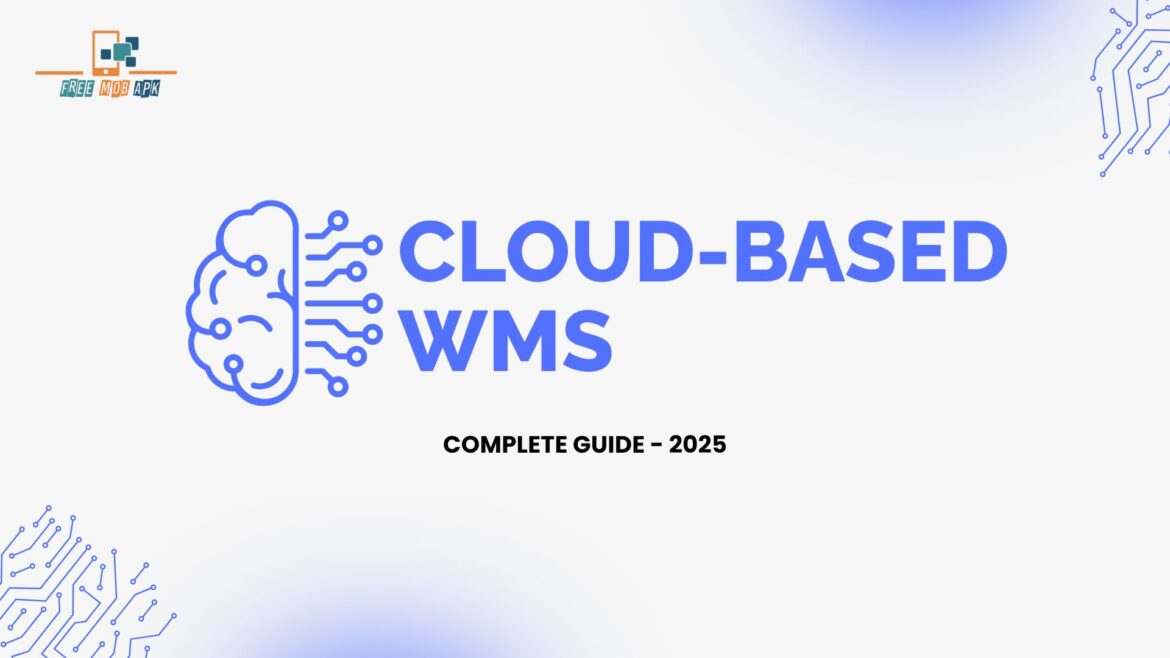A cloud-based Warehouse Management System (WMS) is a digital tool that helps you run warehouse operations through the internet, no bulky servers or complex in-house setups required. Instead of buying and maintaining hardware, you simply subscribe to the service, much like streaming platforms.
This setup means you get instant access to updates, can scale easily as your business grows, and avoid the heavy IT costs that come with traditional systems
This guide breaks down what cloud WMS is, how it works, why it’s better than traditional systems, and what features and benefits you can expect as warehouse operations continue to evolve.
What are Warehouse Management Systems?
A Warehouse Management System (WMS) is software designed to optimize everyday warehouse tasks such as:
- Inventory tracking – Monitors stock levels, locations, and movements in real time
- Order fulfillment – Picking, packing, and shipping accuracy
- Labor management – Task assignments and workforce efficiency
- Reporting & analytics – Insights to improve warehouse performance
With a good WMS in place, businesses can reduce errors, speed up processes, and boost supply chain performance.
Difference Between Cloud-Based and On-Premise WMS
Understanding the differences between cloud-based and on-premise WMS can help businesses choose the right solution based on their needs, budget, and long-term goals.
Deployment
- Cloud-Based WMS: Accessed online, hosted on cloud servers.
- On-Premise WMS: Installed locally, requires in-house hardware.
Scalability
- Cloud-Based WMS: Instantly scalable with business growth
- On-Premise WMS: Scaling requires more hardware and setup
Maintenance & Updates
- Cloud-Based WMS: Provider handles updates and security.
- On-Premise WMS: Internal IT must manage upgrades and support.
Accessibility
- Cloud-Based WMS: Use from anywhere with internet access.
- On-Premise WMS: Limited to on-site or requires remote setup.
Security & Backup
- Cloud-Based WMS: Built-in encryption, auto-backups.
- On-Premise WMS: Must be managed internally.
How Does It Work?
A cloud-based WMS gives businesses the ability to oversee and control warehouse activities in real time, no matter where they are.
Since the system is hosted online, team members can log in from any internet-connected device, making it easy to stay aligned and manage operations across multiple sites without being tied to a single location.
This system keeps data updated constantly, offering real-time inventory tracking, automated processes, and improved overall efficiency.
Businesses usually pay for it as a subscription (Software as a Service or SaaS), avoiding expensive hardware costs while enjoying automatic updates, built-in security, and the ability to scale as needed.
Key Features of a Cloud-Based WMS

A cloud WMS includes several important features that help streamline warehouse operations:
- Inventory Management – Monitors stock levels, locations, and movements in real time to avoid overstocking or running out.
- Order Fulfillment Tools – Improve speed and accuracy of picking, packing, and shipping.
- Warehouse Automation Integration – Works with technologies like robots, conveyor belts, and automated storage systems.
- Labor Optimization – Assigns tasks and tracks productivity by role or shift.
- Analytics & Reporting – Delivers real-time data on performance to support smarter decisions.
- Multi-Warehouse Support – Lets businesses manage multiple sites from one platform.
- Security & Compliance – Keeps data safe with encryption, user access controls, and regular backups to meet industry standards.
Integration with Warehouse Operations
A cloud-based Warehouse Management System (WMS) seamlessly integrates with a wide range of warehouse technologies to enable streamlined, automated operations. It connects with Enterprise Resource Planning (ERP) and Transportation Management Systems (TMS) to ensure consistent, real-time data flow throughout the supply chain.
These systems also interface with barcode scanners, RFID readers, and IoT devices to enhance inventory accuracy and enable live tracking. Additionally, most cloud WMS solutions are built to work with third-party logistics (3PL) providers, e-commerce platforms, and shipping services, allowing for faster order fulfillment and more efficient last-mile delivery.
These integrations help warehouses boost productivity, reduce manual errors, and operate more efficiently without constant hands-on management.
Benefits of Using Cloud WMS Software
Switching to a cloud-based Warehouse Management System brings a range of benefits that help businesses stay agile, efficient, and cost-effective in a dynamic market:
- Scalability on Demand: Quickly adjust system capacity to match business growth or seasonal spikes, no need to invest in additional servers or infrastructure.
- Real-Time Inventory Tracking: Get instant visibility of inventory across all locations, leading to faster decisions and fewer stock issues.
- Lower Costs: Avoid expensive hardware and maintenance.
- Strong Security: Benefit from built-in data protection features like encryption, automatic backups, and disaster recovery.
Using a cloud-based WMS allows businesses to cut costs, boost warehouse performance, and respond quickly to changes in the market.
Types of Cloud-Based Warehouse Management Systems

Cloud-based warehouse management systems (WMS) come in different formats, each offering varying levels of cost, customization, and control depending on the business. The most common types include Software-as-a-Service (SaaS) WMS, private cloud WMS, and an additional type of web-based WMS platforms, each designed to suit different operational and budgetary needs.
SaaS WMS vs. Private Cloud WMS
1. SaaS WMS (Software as a Service)
This model is hosted by a third-party provider and works on a subscription basis. It’s a shared (multi-tenant) system that requires no hardware or IT team on your end. Updates are automatic, and the system scales easily as your business grows. It’s a great fit for companies that want a simple, affordable, and low-maintenance solution.
2. Private Cloud WMS
A Private Cloud Warehouse Management System is hosted in a dedicated cloud environment, meaning the entire infrastructure is reserved for a single organization. Unlike public SaaS solutions that share resources across multiple users, a private cloud setup gives businesses full control over their system.
This approach is especially valuable for companies with strict security requirements, industry-specific compliance needs, or highly customized workflows. With a private cloud WMS, organizations can fine-tune performance, security settings, and features to align with their unique operational demands.
Point: A SaaS-based WMS is ideal for businesses that prioritize low costs and simplicity, while a private cloud WMS suits organizations that need greater control over their data and the flexibility to customize features.
Web-Based Warehouse Management Systems
A web-based Warehouse Management System (WMS) is a cloud-powered solution that allows users to oversee and control warehouse activities straight from a web browser. There’s no need for on-site installations or bulky hardware, everything runs online, making it easy to access the system from anywhere with an internet connection.
This makes it especially valuable for businesses with distributed teams or multiple warehouse locations, offering the flexibility to manage operations remotely while scaling effortlessly as the business grows..
Challenges and Considerations When Implementing a Cloud-Based WMS
Adopting a cloud-based Warehouse Management System (WMS) can bring impressive advantages like scalability, flexibility, and reduced IT overhead. However, moving to the cloud isn’t without its hurdles. Successful implementation requires organizations to navigate several key challenges that could affect performance and integration.
Key Challenges to Keep in Mind

1. Data Security Risks
Storing critical business data in the cloud raises understandable concerns about security. The risk of data breaches, unauthorized access, or loss of sensitive information is a top priority for many organizations. Although most cloud providers offer strong encryption, regular backups, and disaster recovery plans, it’s crucial for businesses to vet providers carefully and ensure compliance with industry-standard security practices.
2. Integration with Existing Systems
Many companies operate on legacy systems that weren’t designed with the cloud in mind. Integrating a modern WMS with outdated software or hardware can be a slow and complex process. Without a well-planned integration strategy, businesses may face data inconsistencies or operational delays. Custom connectors, APIs, and thorough testing are often required to bridge the gap between old and new systems.
3. Regulatory and Compliance Requirements
Different industries and regions have specific data protection and privacy regulations, such as GDPR in Europe or HIPAA in the healthcare sector. Organizations must ensure that their cloud WMS provider complies with all applicable laws.
4. Long-Term Cost Implications
Although cloud solutions can reduce upfront capital expenses by eliminating on-premise hardware, they come with ongoing costs. Monthly or annual subscription fees, charges for data usage, and add-on services can add up over time. It’s important to evaluate the total cost of ownership and ensure the pricing model aligns with your long-term budget.
5. Downtime and Service Reliability
Relying on a cloud provider means trusting them to maintain high levels of uptime and performance. Any outage or disruption in service can directly affect warehouse operations. Organizations should review their provider’s track record and secure a strong Service Level Agreement (SLA) to ensure reliability, timely support, and quick recovery from unexpected downtime.
The Future of Warehouse Management with Cloud Solutions
Warehouse management is rapidly evolving and cloud solutions are leading the charge. With benefits like flexibility, scalability, and instant data access, cloud-based Warehouse Management Systems (WMS) are transforming how businesses run their operations.
As more companies integrate digital transformation, cloud WMS will become even more essential for streamlining workflows, making smarter decisions, and improving customer service.
Key Trends in Cloud-Based Warehouse Management
1. Growing Use of Multi-Cloud Strategies
To reduce risk and increase flexibility, businesses are turning to multi-cloud environments. By using more than one cloud provider, they avoid being too dependent on a single platform, improve redundancy, and tailor their setup to suit different regions or functions. This trend supports stronger, more scalable warehouse systems.
2. Smarter Insights with Real-Time Analytics
Modern cloud WMS platforms now offer advanced analytics that deliver real-time insights into warehouse performance. Managers can use this data to better manage inventory, staff resources, and order fulfillment. Predictive analytics also helps forecast demand, reduce costs, and boost overall efficiency.
3. Seamless Global Integration
As companies expand worldwide, they need systems that work across borders. Cloud WMS solutions make it easier to manage warehouses and supply chains in different regions through centralized, real-time control. This enables better coordination and faster, more accurate logistics on a global scale.
4. Customization and Flexibility on the Rise
Today’s cloud WMS solutions offer greater flexibility, allowing businesses to tailor features to their specific needs. Whether it’s for retail, e-commerce, or manufacturing, companies can adapt their WMS to fit unique workflows, inventory models, and operational goals—making the system a perfect fit for any industry.
Final Words
A Cloud-Based Warehouse Management System (WMS) is an internet-hosted software solution that optimizes inventory tracking, order fulfillment, and labor management without costly on-premise infrastructure.
Unlike traditional WMS, it operates on a subscription model, offering scalability, real-time data access, and automatic updates. This article explores its key features, benefits (cost efficiency, flexibility, security), and types (SaaS, private cloud).
It also addresses implementation challenges (data security, integration) and future trends like AI, IoT, and multi-cloud adoption, highlighting how cloud WMS transforms modern warehouse operations for agility and efficiency.

